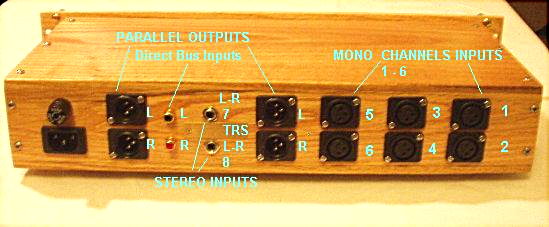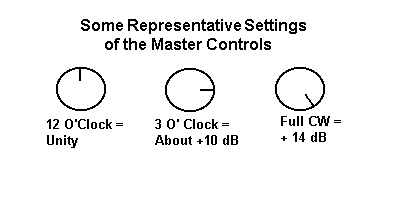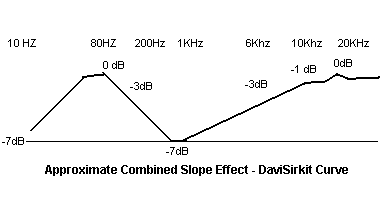The TB-11 "DaviSumThing" Mixer
On-Line Applications Manual

The TB-11 ... Introduced August, 2005

The TB-11 "DaviSumThing" Mixer
On-Line Applications Manual

The TB-11 ... Introduced August, 2005

OVERVIEW -
The TB-11 is, to paraphrase Einstein, a "simple as it gets ... but not simpler", fully professional, archive quality,
line-level analog audio mixer.Since the inception of digital audio workstations many recordists have noticed "something" amiss in the results of their of their digital mixing combining efforts. This mysterious intangible is readily apparent to many veteran, keen-eared professional recording engineers while not apprent to some others. This tends to support the controversy and debates that have ensued throughout the various public forums in recent months.
Regardless of whether you are one who can hear "something" ... some form of "digital artifact" as a result of digital audio signal combining in the digital realm ... those of us who have heard it will not be convinced by any amount of argument that is based on the supposition "it should not be (mathematically speaking) so therefore it isn't".
Furthermore, there will ALWAYS be those of us who simply prefer mixing, and in some cases there will be those (like me-HD) who prefer conducting ALL of our audio processing, completely in the analog realm only going to digital in the final mix !
Thus, we have a renewed demand for a small, portable mixer that is basic in function yet totally "as good as it gets" in terms of signal handling. Thus, we now offer the DaviSound TB-11 "DaviSumThing" line level analog audio mixer.
So, whether you just want precision analog,archive quality mixing offering signal integrity that is just not available with most cheap, mass manufactured mixers, or whether you want to cure that mysterious "digital something" ... we believe you now have the answer with the analog "DaviSumThing"!
The TB-11 offers six mono input channels via XLR (female) input jacks (1-6) and two TRS "stereo" jacks for two separate, stereo inputs (channels 7 & 8). Plus, it also provides two RCA jacks for direct access to the left and right main busses.
The output capabilities are two pairs of XLR (male) left and right paralleled (divider isolator distributed) output jacks.
While it has become the new trend as part of the DaviSound WG styling, to eliminate all markings and labeling from the panels of DaviSound "WG" processors for aesthetics reasons, it is, admittedly, somewhat questionable practice in the design and application of a unit housing more than four channels. 

While there will be many users who can still appreciate the "mystique" and prestige offered by the employment of completely "marking free" control and connector panels, there will also be many more who prefer the practicality of labels, at least numbered channel designations. We do suggest that users who prefer numbered channels use discreetion in the type of labeling applied so as not to deface the unit. Temporary labelings would be preferable to permanent fixations.
One workable solution is to simply print, or hand label, a paper legend to accompany the unit resting on the workspace, out front of the panel, with numbers corresponding to the directly adjacent channel knobs. Another alternative may be to affix a temporary write-on strip to the workspace, adjacent to the mixer.
If rack mounting, you can simply add a 1RU rack mountable write-on strip below the TB-11 in the rack.
ACTIVE MIXING -
The TB-11 employs "active summing" a technique which has been the virtual (pun?) "standard" of all mixers designed in recent decades since the advent and proliferation of operational amplifiers into professional audio application."Virtual" is, indeed, the keyword since all operational summing amplifiers operate on the "virtual ground" summing junction principal. "Virtual ground" is a property of a feedback inverting amplifier, at its inverting input junction, when joined to resistive coupled sources of the proper ratio to the feedback resistance at that point.
The "virtual ground" summing junction is so named because it "behaves" exactly like a ground termination to all of the source resistances and impedances connected to it. While the combined signals of all of the sources will appear, mathematically added proportionately at the output of the amplifier, there is no measurable audio signal detectable at this "magic" summing junction itself! Therefore, it is, electrically, the same potential as circuit ground for
audio signals.This property, then, obviously makes for an ideal mixer since it effectively isolates all of the sources connected to it from each other (as if they were all terminated and joined at ground instead of to each other) while adding their respective signals alegebraically at the amplifier stage output!
The TB-11 employs one section of our MP-1, Universal Amplifier, "MasterPiece" module for the important job of the "summing amp" in our design. Since the signals at the output of a virtual summer are always phase invereted, a second amplifier stage is employed as an output buffer and phase restorer whereby the mixer's overall output is in identical electrical phase as that of the input signals.
We use the second half of a our MP-1 dual universal amp modules as this buffer stage and operate it as a variable "active gain" stage whereby the unit's master controls directly control the gain of the output amplifier stage in fully variable fashion from minus infinity to +14 dB.
Setting the master control to 12 O'Clock will set the stage for approximately "Unity" through gain; whereas, the output may be continuously varied for an overall gain of around + 14dB from the TB-11 as shown by the graphic approximations below.
While the actual trimmming of the masters is, of course, at the discreetion of the user, it is important to keep some basic guidelines of good engineering practice in mind when operating your TB-11. For example, for the very best signal to noise ratio in the chain, it is of course always desirable to operate the inputs at as high a level as is practical with minimal makeup gain as required. 
It is suggested that a good operating point for the TB-11 may be with masters set at 12 O'Clock nominally and the inputs adjusted accordingly as needed. However, the full range of the Master controls may be employed without worry, where needed, as the noise, crosstalk and headroom performance of the TB-11 is exceptional for a simple mixer and will allow results of full integrity at any setting. We simply mention that the highest theoretical performance of any mixer will occur with the mixer stage operating at near unity gain while the individual inputs are adjusted
as needed.In practice, it will be found that the master settings will likely always be typically operated somehere between
the 10 O'Clock and 2 O'Clock positions.
The input controls of the first six channels are mono and are routed via the panpots above each control in typical panoramic potentiometer fashion to either extreme left or right settings, center or anywhere between in continuously variable fashion. The center panpot position will route the input signal to both output channels equally. 
The input controls for each of the last pair of input channels, 7 and 8, are true STEREO controls adjusting the levels of the Tip/Ring (left/right) input signals simultaneously. The outputs of these controls are routed across the adjoining "BALANCE" controls allowing a balance trim of relative levels between channels where desired. Normally the Balance control will be operated in the center position.
HEADPHONES -
The front panel of the TB-11 provides for a headphone jack for setting up and monitoring however, it is NOT buffered by a separate amplifier stage and for this reason offers no independently adjustable volume control. Since it is not buffered but functions as a section of the main output divide network, it is made switchable so as to be at the discreetion of the operator whether to utilize the phone feed simulataneous with a main output feed.Some loading of the outputs will result with the actual amount of signal level drop dependent upon the type, and the impedance load, of the partcicular headset utilized. The headphone network is built-out with additional 100 ohm isolation resistors for a total output impedance of about 300 ohms at the headphone jack.
The headphone jack is offered primarily for test/setup purposes but is made siwtchable so that it may be used simiultaneous with a program feed whenever the operator has determined that the chosen headset does not adversely affect the main mix. However, aside from a slight overall level loss, the isolation divide networks, and the stable drive capability of the MP-1 output module buffers, will normally insure that the signal is not adversely but most headset loads.
The front panel headphone jack could, also, obviously be used as an auxillary unbalanced line output as well with the TRS connector configured as sleeve ground, Ring- Right and Tip-Left.
DaviSirkit - The middle most toggle switch controls the "DaviSirkit" pre-set, passive EQ function which is offered as a selectable option between the two MP-1 amplifier stages.
The DaviSirkit EQ is essentially a passive dip filter whose response curve approximates that shown in the response graph below.

When using this feature it may be desirable to boost the Master controls slightly to compensate for the insertion loss of the midrange dip. In that case, the circuit has the same affect as a shelving equalizer with about
7 dB of bass/treble boost.REAR PANEL-
The rear connections are laid out in a logical manner while affording the most direct path for their respective
internal connections.
Note that the XLR inputs are laid out right to left with the first pair, farthest right. The odd channels are the top row and the even numbered channels the bottom row. 
You will also notice that the two male output pairs are separated and the alternate inputs, the TRS jacks and the direct RCA jacks, located between these output pairs.
Frequency response, (as-is, un-compensated, unity gain, .775 V RMS input ) ...
flat to 10 MHZ
Input Noise Voltage at 1KHZ - less than 4 nanovolts per stage
Typical Supply current - 11 mA (maximum- at full gain- full load)
THD at unity gain, per inverter stage less than .0002%
Slew Rate 12 V/uS
Maximum Supply Voltage + 48 volts
Lifespan- unknown - absolute minimum expected performance ...
under less than ideal thermal conditions - 20 years ...
Typical expected performance under average operating conditions - 100 plus years ...
Theoretical performance under ideal conditions - 1,000 years!
ELECTRICAL SPECIFICATIONS OF THE TB-11 MIXER
Frequency Response flat from 1.6 Hz to 20 KHz -3 dB at 36Khz Circuit Noise and main channel crosstalk better than -90dB
(all measured with individual controls FULL CW and Master Controls at 12 O'Clock)Input Channel to Input channel crosstalk better than -84 dB panpots centered Mono Input channel (1-6) left/right assign crosstalk bettter than -78 dB
panpots extreme rotatation.Stereo input channel crosstalk, better than -90dB THD and all known distortions below test residuals (better than .0008%) Input impedance just under 10 Kohms, Output impedance (main XLRs) 150 ohms Maximum useable signal level approximately +28 dBU
with peak clipping around +30 to 32 dBU
INTERFACE CONNECTIONS -
When employing a mixer of any kind, where many signals from many pieces of assorted equipment of varying design are brought together, or even where many separate channels of one piece of outboard gear are brought together, or any combination thereof, any and all of which will offer unique considerations, it is most important to pay attention to the wiring schemes and connectors employed.Hopefully the TB-11 will be more forgiving than most when it comes to interface with the outside world, however there are certain procedures that should ALWAYS be followed and adhered to.
The input channels of the TB-11 are uniquely configured to accomodate both inputs from balanced or unbalanced sources in any combination. However, it is important that when using the inputs balanced that pin 2 be consistently (ALWAYS) "HI" (hot) whatever your term, normally corresponding to the positive going waveform excursion. Pin 3 will be "low" and pin 1 will be ground.
When using the unit to accomodate unbalanced inputs to the XLR inputs, pin 2 must ALWAYS be the signal connection while the ground connects to pin 1. Pin 3 may be grounded or left unused in unbalanced application
either way.When driving balanced equipment from the outputs, the same arrangement holds true, pin 2 is HIGH and
pin 3 IS LOW with pin 1 ground or shield.In some case you may find it desirable, or even necessary, to use a cable with the shield lifted, or disconnected at one end. This would be tried if hum or buzz is noticable from any piece of gear that may be connected at multiple locations in your setup. In extreme ground loop situations, extensive experimenting with cable ground arrangements may be necessary to acheive acceptable results.
However, the TB-11, because of our unique input/output accomodations as well as our impeccable internal grounding schemes, should be more impervious to ground loops and connection problems than most mixers you may have been accustomed to previously. The electrical ground isolation afforded by the wooden cabinet further enhances the internal grounding stability of the TB-11.
Nonetheless, good engineering practice should always be followed to the letter and all efforts made to acheive proper interface at every hookup and application.
There are two RCA jacks provided at the rear panel which are the direct bus injection inputs providing a total of twelve separate inputs for the TB-11. These may be used to cascade another TB-11, or any other outboard mixer or processor, directly to the mix bus at unity level. They may also be used for effects loop returns in conjunction with one of the sets of outputs functioning as the loop send.
CABINET- The rack cabinet itself is made from hand sculptured SOLID, natural wood. As of spring 2001, we have opted for lustrous, hard penetrating oil finishes for the cabinetry as this provides added protection for the wood and, unlike other oil finishes, it is relatively maintenance free. Simply wipe it with a soft dry cloth to restore lustre. The front and rear panels are treated with extra coatings of acrylics for added protection.WG Models are entirely made of wood! The front panel as well as the rest of the cabinet are ALL solid oak (unless other exotic woods have been utilized by client arrangement/preferance). Like all natural things, every piece of wood has its own, distinct character and "personality". This makes EACH AND EVERY "WG" model unique unto itself which enhances the aesthetic value of the piece and the actual appreciative monetary value as well!
Keep in mind that as part of this wood "character" it is impossible to find/utilize a "PERFECT" piece of wood. This means there may be slight imperfections, or variations, in terms of grain pattern, color uniformity, and skew. However, any such natural variations in our selected pieces are very minor and are the very thing that gives wood its charm and "character" appeal!
There are NO user servicable parts inside. DaviSound Tool Boxes are fashioned from our "Master Pieces" modules which employ hand-laid circuitry, silicon embedded into plastic cased modules. In the unlikely event that service should ever be required, simply contact us for return authorization and we will replace the defective module(s).
While never having been enforced, it has always been original DaviSound policy to void warranties if the cover is removed! However, certainly be advised that ANY internal tampering or unauthorized repair or modification attempts void all warranties!
DaviSound products are carefully assembled BY HAND, one piece at a time from start to finish, in prototype assembly fashion, with extreme care and attention. They are designed to perform from now on with no trouble.However, there are always "real world" imperfections that can not be anticipated or accounted for no matter HOW careful one might be in fabrication. For example, we don't make the ICs and we don't wind the power transformers and these things can fail at times. Ours seldom do, due to extensive testing and pre shipment "burn-in" periods, but if you should ever have a problem, you are protected for as long as you own the equipment, as the original owner.
Simply carefully repack the unit in the original packing, ship it back to us (after notification) to
DaviSound, 1504 Sunset Ave., Newberry, SC 29108, 803-276-0639
and we will repair and reship at no charge to you (the original owner) whatever!Thank you for your purchase and use of a DaviSound Tool Box!
And, we also thank you for allowing us to go these "extra lengths" within YOUR operating manual to elaborate in accordance with our "mission" in publishing these on-line manuals. It is all part of an ongoing effort to provide as much educational material as possible from this website in the sincere belief that ...
The more one truly KNOWS about audio electronics ...
the more one can truly appreciate the unique DaviSound methods!
We thank all of you who ALREADY know all of this covered herein for your indulgence as we present it for those who do not!
Please let us hear from you regarding your application of our unit and feel free to contact us with any questions or comments throughout the future!
We also hope that you will consider ALL of the DaviSound Tool Box models for your rack!
THANK YOU and GOOD LUCK!
Back To ...